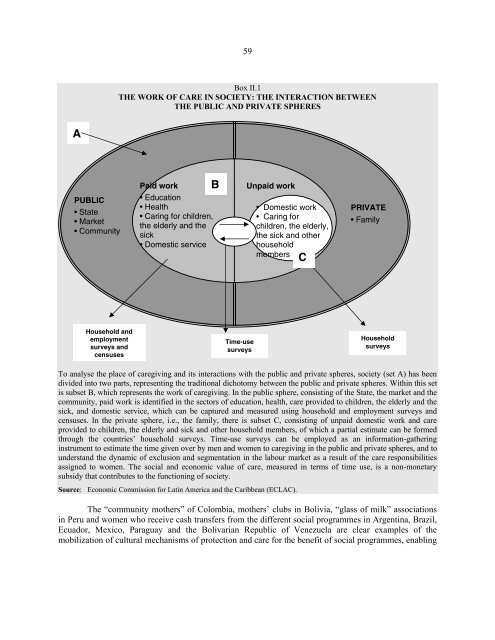Women in Latin America and the Caribbean - Cepal
Women in Latin America and the Caribbean - Cepal
Women in Latin America and the Caribbean - Cepal
Create successful ePaper yourself
Turn your PDF publications into a flip-book with our unique Google optimized e-Paper software.
59<br />
Box II.1<br />
THE WORK OF CARE IN SOCIETY: THE INTERACTION BETWEEN<br />
THE PUBLIC AND PRIVATE SPHERES<br />
A<br />
PUBLIC<br />
• State<br />
• Market<br />
• Community<br />
Paid work<br />
• Education<br />
• Health<br />
• Car<strong>in</strong>g for children,<br />
<strong>the</strong> elderly <strong>and</strong> <strong>the</strong><br />
sick<br />
• Domestic service<br />
B<br />
Unpaid work<br />
• Domestic work<br />
• Car<strong>in</strong>g for<br />
children, <strong>the</strong> elderly,<br />
<strong>the</strong> sick <strong>and</strong> o<strong>the</strong>r<br />
household<br />
members<br />
C<br />
PRIVATE<br />
• Family<br />
Household <strong>and</strong><br />
employment<br />
surveys <strong>and</strong><br />
censuses<br />
Time-use<br />
surveys<br />
Household<br />
surveys<br />
To analyse <strong>the</strong> place of caregiv<strong>in</strong>g <strong>and</strong> its <strong>in</strong>teractions with <strong>the</strong> public <strong>and</strong> private spheres, society (set A) has been<br />
divided <strong>in</strong>to two parts, represent<strong>in</strong>g <strong>the</strong> traditional dichotomy between <strong>the</strong> public <strong>and</strong> private spheres. With<strong>in</strong> this set<br />
is subset B, which represents <strong>the</strong> work of caregiv<strong>in</strong>g. In <strong>the</strong> public sphere, consist<strong>in</strong>g of <strong>the</strong> State, <strong>the</strong> market <strong>and</strong> <strong>the</strong><br />
community, paid work is identified <strong>in</strong> <strong>the</strong> sectors of education, health, care provided to children, <strong>the</strong> elderly <strong>and</strong> <strong>the</strong><br />
sick, <strong>and</strong> domestic service, which can be captured <strong>and</strong> measured us<strong>in</strong>g household <strong>and</strong> employment surveys <strong>and</strong><br />
censuses. In <strong>the</strong> private sphere, i.e., <strong>the</strong> family, <strong>the</strong>re is subset C, consist<strong>in</strong>g of unpaid domestic work <strong>and</strong> care<br />
provided to children, <strong>the</strong> elderly <strong>and</strong> sick <strong>and</strong> o<strong>the</strong>r household members, of which a partial estimate can be formed<br />
through <strong>the</strong> countries’ household surveys. Time-use surveys can be employed as an <strong>in</strong>formation-ga<strong>the</strong>r<strong>in</strong>g<br />
<strong>in</strong>strument to estimate <strong>the</strong> time given over by men <strong>and</strong> women to caregiv<strong>in</strong>g <strong>in</strong> <strong>the</strong> public <strong>and</strong> private spheres, <strong>and</strong> to<br />
underst<strong>and</strong> <strong>the</strong> dynamic of exclusion <strong>and</strong> segmentation <strong>in</strong> <strong>the</strong> labour market as a result of <strong>the</strong> care responsibilities<br />
assigned to women. The social <strong>and</strong> economic value of care, measured <strong>in</strong> terms of time use, is a non-monetary<br />
subsidy that contributes to <strong>the</strong> function<strong>in</strong>g of society.<br />
Source: Economic Commission for Lat<strong>in</strong> <strong>America</strong> <strong>and</strong> <strong>the</strong> <strong>Caribbean</strong> (ECLAC).<br />
The “community mo<strong>the</strong>rs” of Colombia, mo<strong>the</strong>rs’ clubs <strong>in</strong> Bolivia, “glass of milk” associations<br />
<strong>in</strong> Peru <strong>and</strong> women who receive cash transfers from <strong>the</strong> different social programmes <strong>in</strong> Argent<strong>in</strong>a, Brazil,<br />
Ecuador, Mexico, Paraguay <strong>and</strong> <strong>the</strong> Bolivarian Republic of Venezuela are clear examples of <strong>the</strong><br />
mobilization of cultural mechanisms of protection <strong>and</strong> care for <strong>the</strong> benefit of social programmes, enabl<strong>in</strong>g











